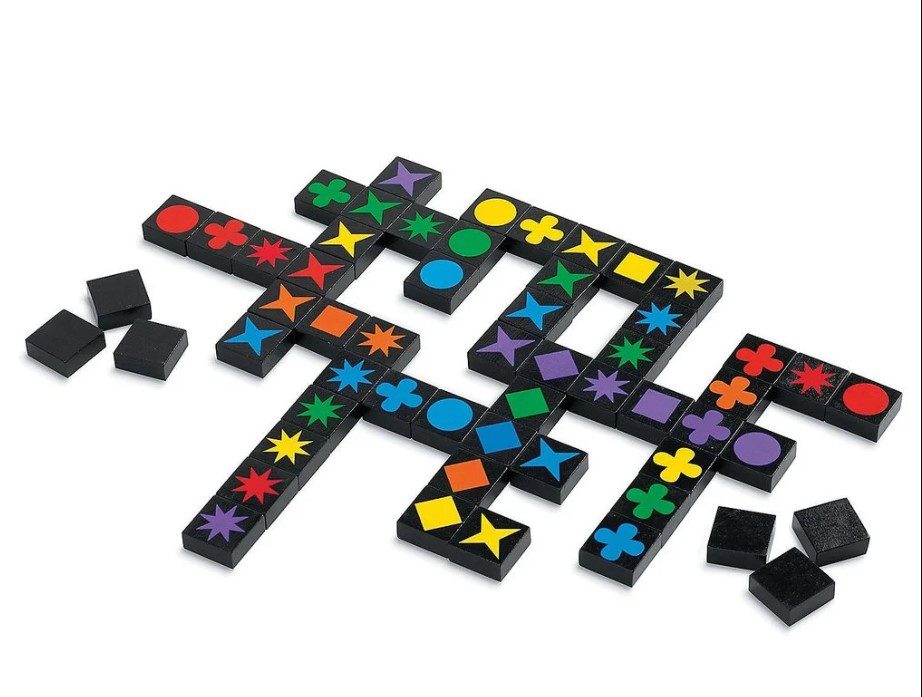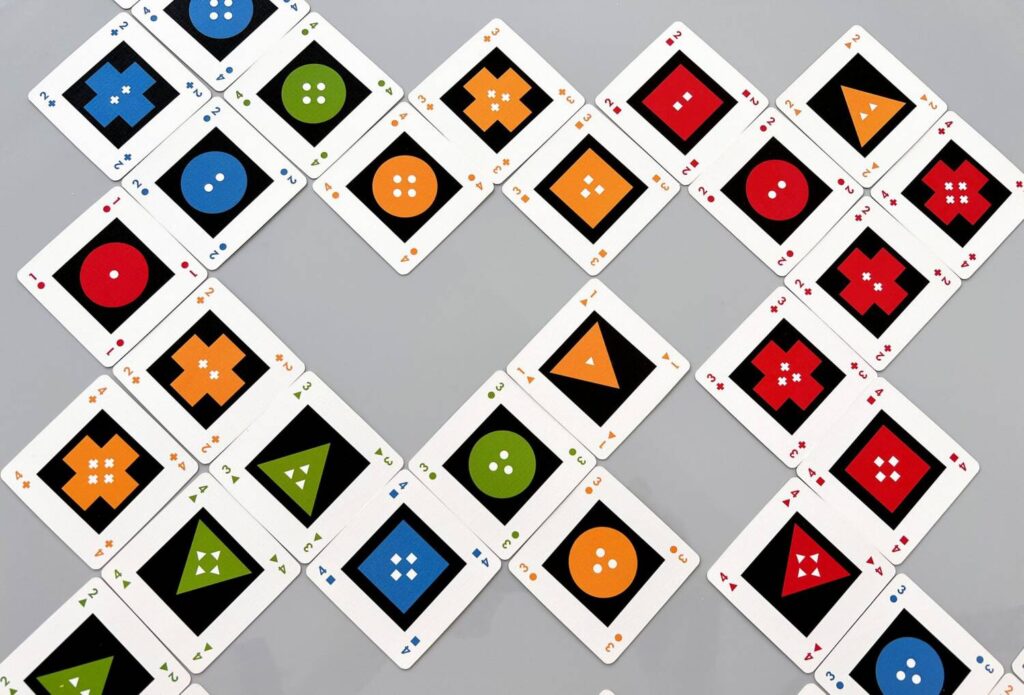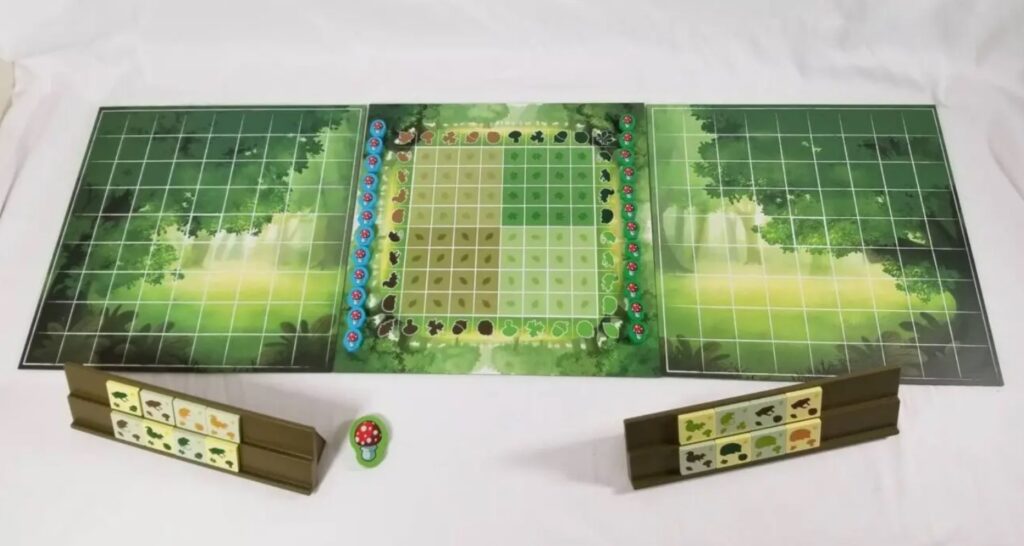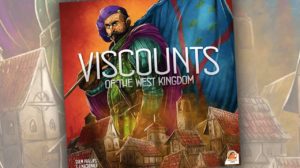At some point in each of our lives, each one of us has been asked to identify the items, in a group of other items, that are exactly the same. The simple act of matching items together is a springboard for further concepts. Show me the bananas. What do they have in common? What are their differences? How do they differ from the other items that are not bananas? Looking at this group of items, is there some commonality between them all? What is the meaning of life?
In today’s Board Game Step Ladder, we’re going to explore games that take the concept of matching to its extreme.
Qwirkle > IOTA > The Glade
Qwirkle
Designed by Susan McKinley Ross in 2006, the 2011 Spiel des Jahres winner Qwirkle has become a staple of many families’ board game collections, and for good reason. It’s easy to teach, easy to learn, highly approachable, and its large, brightly colored tiles have a magnificent table presence. It’s the type of game that catches the eye and draws you in.
Qwirkle is made up of a collection of tiles featuring six distinct shapes in six distinct colors. During setup, each player draws six tiles from the bag and keeps them hidden from the other players. On their turn, a player will lay out tiles from their hand into a common tableau, following certain pattern-building rules, in order to score points. Then they will draw back up to six tiles before passing play to the next player in line.
The rules for laying down tiles are easy. Firstly, the tiles you lay down must be orthogonally adjacent to any pre-existing tiles. Secondly, the pattern you create can consist of tiles that are all the same shape or all different colors, with no repeats. For instance, you can play out an orange circle, a red circle, and a blue circle. But you cannot play out a second orange circle with these as that would violate the “no repeats” rule.

Then, you score points for each tile in the row or column that you affected. In this instance, you would score three points. If you manage to complete a line of six, then you score six additional points—a ‘qwirkle’ in the game’s nomenclature. Like Scrabble or Azul, it’s possible that laying down tiles may create multiple groups of tiles. In this case, you’d score for each of those groups. Also, similar to Scrabble, players may opt to skip their turn to exchange tiles from their hand with different tiles drawn from the bag.
It’s a pretty easy game once you get the hang of it, and that’s largely due to there only being a few things to keep track of: the shape and the color. But, what if you added a third element? That would ramp up the difficulty quite a bit. Which is exactly that the next game on the ladder does.
Say hello to IOTA.
IOTA
IOTA (designed by Gene Mackles and published by Gamewright Games), is (as the text on the front of the packaging states) a great big game in a teeny-weeny tin. Inside of this tin is a deck of 66 cards; each of which contains three pieces of information: a color, a shape, and a number (red, triangle, 3 for example). In total, there are four different colors, four different numbers, and four different shapes. There is at least one card in the deck for every permutation of these, plus two wild cards.
Like Qwirkle, players are playing cards to a shared tableau. And, much like Qwirkle, players can play cards into rows where shape, color, or number match with no repeats allowed. Players can also opt to skip their turns in favor of discarding cards to draw some new ones. But, that’s where the similarities to Qwirkle end.
Unlike Qwirkle, not everything has to match all the time. Got four cards that have no characteristics in common? You’re in luck. In IOTA, even cards that are completely different are considered a set. The first card you lay down in a row or column establishes that row or column. The second card laid down establishes the rules for it. For instance, if you lay down the Red Triangle 3 mentioned earlier followed by a Red Triangle 2, then you’ve established that the row or column must contain cards that are red triangles and those cards must have different numbers. You could just have easily laid down a Blue Circle 3 as the second card. That would establish that the row or column must contain the number 3 but have different shapes and colors.

Another way that IOTA differs from Qwirkle is in the way that scoring is performed. In Qwirkle, you’re essentially earning one point per tile that was involved, with the occasional opportunity for a bonus. In IOTA, you score points equal to the total of the face values of the rows and columns you’ve added to. So, a row of four cards that have the number 4 on them will be more valuable than a row of four cards numbered 1 to 4.
On the surface, it doesn’t seem like IOTA is really that different from Qwirkle, but that additional piece of information (the number) coupled with the concept that four things that share nothing in common are also considered a set ramp up the difficulty considerably. That’s why IOTA sits above Qwirkle on the ladder.
Our next game takes everything you’ve learned and really puts it to the test.
Welcome to The Glade.
The Glade
In The Glade, designed by Richard Breese (of Keyflower fame), players will be drawing tiles from a bag, adding them to their tile rack, and then placing tiles into their tableau to create sets and score points. And when all is said and done and the last leaf has fallen, the player with the most points wins.
Unlike the previous two games on this list, each player has their own separate player board. Also, unlike the other two, in The Glade, the scoring occurs at the end of the game. While a game of Qwirkle or IOTA might see players’ scores in the 100+ range, a game of The Glade typically averages out to scores in the mid-20s, and those points are hard wrought.
Like IOTA, the tiles in The Glade have three sets of characteristics: four different colors, four different animals, and four different types of forest fruits. When it comes to placing tiles from your hand into your playing area, the tiles are placed as sets. A set is defined as “1‒4 tiles that have at least 1 shared characteristic and other characteristics that are either all the same or all different”. There is one tile for each different permutation and there are two sets of these tiles, for a total of 128 tiles.
On your turn, you have two options. First, you can place 1-4 tiles from your rack into your display in such a way that every tile placed adds to, or forms, a set. If you only add 1 or 2 tiles, nothing special happens. But, if you add 3 tiles, then you’ll determine which fourth tile would complete the set of 4 and mark that on the central Glade board with one of your toadstools. If the tiles only share a single characteristic, you use the single toadstool side. If they had two characteristics in common, you mark the missing tile with your double toadstool side.
Your other option is to use one of your tiles to complete a set, collecting the matching toadstool from the Glade board. This is the main method of scoring points. At the end of the game, any of your toadstools that have been placed out anywhere are worth a point apiece (two if they’re on their double toadstool side), but they’re even more valuable if they have been collected by a player. And, they’re even MORE valuable if a player has placed them into an enclosure. Enclosures occur whenever a single space on your player board is surrounded on all four sides by tiles. Placing a toadstool into one of these allows you to take another action with the tiles remaining on your rack.
Toadstools serve another purpose, too. They’re the game’s timer. If a player runs out of toadstools, the end game is triggered.

So, just to recap: The Glade differs from the other games on this ladder in four main ways: it includes more tiles, gives each player their own play area, allows you to chain actions together through clever play, and encourages more player interaction by way of finishing other peoples’ sets to collect their toadstools to score points. On paper, it might seem like The Glade is not too dissimilar from the other two games on the ladder. But, in practice, these four slight differences make for a very crunchy, brain burning experience.
In The Glade, even though you’re in direct competition with your opponents, you’re also playing against yourself. Each set placed in the now must be carefully considered against the question mark that is the future. Is your placement preventing another set from ever being completed? Are you opening up your board to future plays or are you closing it off? Do you add a set to your own board, or do you spend your turn finishing off another player’s set to collect their toadstool? How close is the game to being completed? Maybe it would be wiser to play out your own toadstools instead of collecting others’. Or maybe… well, you get the point. There’s a lot to think about.

There’s a popular meme out there on the internet of a woman gazing off into space, a pensive look on her face, with mathematical equations floating in the air all around her. Playing The Glade feels a bit like that. And, I love every delicious moment of it.
Pattern matching doesn’t just have to stay relegated to the realm of kid’s games anymore. It’s clear that, if handled correctly by a competent designer, even a simple mechanic can be elevated and turned into something marvelous. Thank goodness for that or we wouldn’t have any of these fabulous games!
Did you enjoy our Step Ladder? Would you set up your ladder differently? Let us know in the comments!












Add Comment